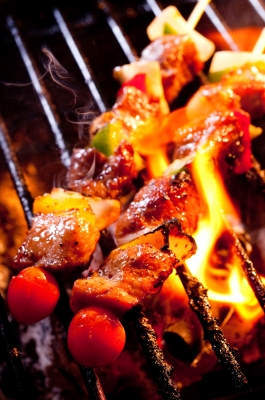Juliana is the oldest of three kids, and the only one of my three kids who was ever overweight. Indeed, at the moment, my son Teddy is technically underweight, with a BMI in the 3rd percentile.
When I was pregnant with and nursing Juliana, I ate a vegetarian diet. When I was pregnant with her sister Molly, I had an overwhelming desire for chicken, and abruptly stopped eating vegetarian after 18 years. So I got to wondering whether there might be a relationship between what I ate while pregnant and nursing and Juliana’s metabolism and ability to handle carbohydrates versus her siblings.
And there could be. Fat mothers produce fatter babies; diabetic mothers (whose blood sugar is on average higher than non-diabetic mothers) produce fatter babies. And the incidence of fat babies is increasingly dramatically, in step with the increase in obese and diabetic adults.
“The probable explanation is that as women of childbearing age get heavier and more of them become diabetic, they pass the metabolic consequences on to their children through what is known technically as the intrauterine environment. The nutrient supply from mother to developing child passes across the placenta in proportion to the nutrient concentration in the mother’s bloodstream. If the mother has high blood sugar, then the developing pancreas in the fetus will respond to this stimulus by overproducing insulin-secreting cells. “The baby is not diabetic,” explains Boyd Metzger, who studies diabetes and pregnancy at Northwestern University, “but the insulin-producing cells in the pancreas are stimulated to function and grow in size and number by the environment they’re in. So they start over functioning. That in turn leads to a baby laying down more fat, which is why the baby of a diabetic mother is typified by being a fat baby.”
Taubes, Gary (2007-09-25). Good Calories, Bad Calories (Kindle Locations 8167-8174). Random House, Inc.. Kindle Edition.
Juliana wasn’t actually a fat baby. But her intrauterine environment was with me eating a vegetarian diet, which was necessarily higher carb than when I switched to being an omnivore with Molly and Teddy’s pregnancies. She was also nursed for several years with me eating a vegetarian diet. I’m not diabetic, but that doesn’t mean Juliana didn’t suffer the consequences of my high-carb eating style:
“There’s no reason to think that the hormonal and metabolic consequences of high blood sugar—from what James Neel in 1982 called the “excessive glucose pulses that result from the refined carbohydrates/ over-alimentation of many civilized diets”—do not pass from mother to child through the intrauterine environment, whether the mother is clinically diabetic or not.”
Taubes, Gary (2007-09-25). Good Calories, Bad Calories (Kindle Locations 8189-8192). Random House, Inc.. Kindle Edition.
I can’t prove that my eating style contributed to Juliana’s carb sensitivity and subsequent overweight–but it’s an interesting association that she is the only one of three kids who experienced my high-carb eating style and she’s the only one with excess weight.


